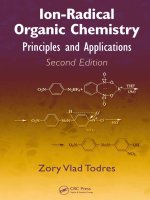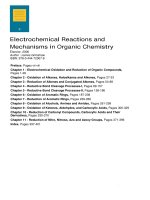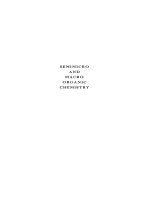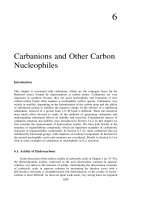Organic chemistry breakthroughs and perspectives
Bạn đang xem bản rút gọn của tài liệu. Xem và tải ngay bản đầy đủ của tài liệu tại đây (9.75 MB, 839 trang )
Edited by
Kuiling Ding and Li-Xin Dai
Organic Chemistry –
Breakthroughs
and Perspectives
www.pdfgrip.com
Related Titles
Christmann, M., Brăase, S. (eds.)
Carreira, E. M., Kvaerno, L.
Asymmetric Synthesis
More Methods and Applications
Classics in Stereoselective
Synthesis
2012
2009
ISBN: 978-3-527-32900-7
ISBN: 978-3-527-29966-9
Hanessian, S., Giroux, S., Merner, B.L.
Steinborn, D.
Design and Strategy in Organic
Synthesis
Fundamentals of
Organometallic Catalysis
From the Chiron Approach to Catalysis
2012
ISBN: 978-3-527-31964-0
Nicolaou, K. C., Chen, J. S.
Classics in Total Synthesis III
Further Targets, Strategies, Methods
2011
ISBN: 978-3-527-32958-8
2011
ISBN: 978-3-527-32716-4
www.pdfgrip.com
Edited by Kuiling Ding and Li-Xin Dai
Organic Chemistry –
Breakthroughs
and Perspectives
www.pdfgrip.com
The Editors
Prof. Dr. Kuiling Ding
Chinese Academy of Sciences
Shanghai Institute of Organic Chemistry
345 Ling Ling Road
Shanghai 200032
China
Prof. Dr. Li-Xin Dai
Chinese Academy of Science
Shanghai Institute of Organic Chemistry
345 Ling Ling Road
Shanghai 200032
China
All books published by Wiley-VCH are
carefully produced. Nevertheless, authors,
editors, and publisher do not warrant the
information contained in these books,
including this book, to be free of errors.
Readers are advised to keep in mind that
statements, data, illustrations, procedural
details or other items may inadvertently be
inaccurate.
Library of Congress Card No.: applied for
British Library Cataloguing-in-Publication
Data
A catalogue record for this book is available
from the British Library.
Bibliographic information published by
the Deutsche Nationalbibliothek
The Deutsche Nationalbibliothek
lists this publication in the Deutsche
Nationalbibliografie; detailed bibliographic
data are available on the Internet at
<>.
© 2012 Wiley-VCH Verlag & Co.
KGaA, Boschstr. 12, 69469 Weinheim,
Germany
All rights reserved (including those of
translation into other languages). No part
of this book may be reproduced in any
form – by photoprinting, microfilm, or any
other means – nor transmitted or translated
into a machine language without written
permission from the publishers. Registered
names, trademarks, etc. used in this book,
even when not specifically marked as such,
are not to be considered unprotected by law.
ISBN Hardcover: 978-3-527-33377-6
ISBN Softcover: 978-3-527-32963-2
ISBN Online: 978-3-527-66480-1
Cover Design Formgeber, Eppelheim,
Germany
Typesetting Laserwords Private Limited,
Chennai, India
Printing and Binding Markono Print
Media Pte Ltd, Singapore
Printed on acid-free paper
www.pdfgrip.com
V
Contents
List of Contributors
Introduction
1
1.1
1.2
1.2.1
1.2.2
1.3
1.3.1
1.4
1.4.1
1.4.2
1.5
1.5.1
1.5.2
1.5.3
1.5.4
1.5.5
1.5.6
XXIII
XXXV
Diversity-Oriented Syntheses of Natural Products and Natural Product-Like
Compounds 1
Ling-Min Xu, Yu-Fan Liang, Qin-Da Ye, and Zhen Yang
Introduction 1
Diversity-Oriented Synthesis (DOS) 2
Diversity-Oriented Synthesis of Skeletally and Stereochemically Diverse
Small Molecules [10a] 3
Biomimetic Diversity-Oriented Synthesis of Galanthamine-Like
Molecules 3
Diverted Total Synthesis (DTS) 7
Diverted Total Synthesis of the Migrastatins 7
Function-Oriented Synthesis (FOS) 9
Syntheses of Novel and Highly Potent Analogs of Bryostatin 10
Discovery of Potent and Practical Antiangiogenic Agents Inspired
by Cortistatin A 11
Target-Oriented Synthesis (TOS) 11
Synthetic Studies and Biological Evaluation of
Ecteinascidin 743 13
Total Synthesis and Biological Evaluation of Biyouyanagin A and
Analogs 15
Total Synthesis of Vindoline, Related Natural Products, and Structural
Analogs 18
Total Synthesis of Eudesmane Terpenes by Site-Selective C–H
Oxidations 19
Total Synthesis of Bipinnatin J, Rubifolide, and Coralloidolides
A, B, C, and E 21
Total Synthesis of Diverse Carbogenic Complexity Within the Resveratrol
Class from a Common Building Block 23
www.pdfgrip.com
VI
Contents
1.6
Conclusion and Perspectives 24
Acknowledgments 26
References 26
Commentary Part 28
Comment 1 28
Michael Foley
Comment 2 29
Scott A. Snyder
Comment 3 30
Da-Wei Ma
Authors’ Response to the Commentaries
References 31
2
2.1
2.2
2.2.1
2.2.2
2.2.3
2.3
2.3.1
2.3.2
2.3.3
2.4
2.4.1
2.4.2
2.4.3
2.5
2.5.1
2.5.2
2.5.3
2.6
2.6.1
2.6.2
2.7
31
Total Synthesis of Natural Products and the Synergy with Synthetic
Methodology 33
Qian Wang and Jie-Ping Zhu
Introduction 33
Domino Process 36
Introduction 36
Total Synthesis of Hirsutellone B 36
Total Synthesis of (±)-Minfiensine, (−)-Phalarine, and Aspidophytine 40
Multicomponent Reactions 43
Introduction 43
Total Synthesis of (−)-Spirotryprostatin B 46
Total Synthesis of Hirsutine 50
Oxidative Anion Coupling 52
Direct Coupling of Indole with Enolate, Total Synthesis of Hapalindoles,
Fischerindoles, and Welwitindolinones 52
Total Synthesis of (±)- and (−)-Actinophyllic Acid 54
Total Synthesis of (−)-Communesin F 56
Pattern Recognition 60
Introduction 60
Total Synthesis of (±)-Aplykurodinone-1 60
Total Synthesis of (±)-Vinigrol 63
Conformation-Directed Cyclization 65
Introduction 65
Cyclosporin and Ramoplanin A2 65
Conclusion and Perspectives 69
Acknowledgments 70
References 70
Commentary Part 72
Comment 1 72
Kyriacos C. Nicolaou
www.pdfgrip.com
Contents
Comment 2 73
Henry N.C. Wong
Comment 3 75
Wei-Dong Li
References 77
3
3.1
3.1.1
3.1.2
3.1.3
3.1.4
3.2
3.2.1
3.2.2
3.2.3
3.3
3.3.1
3.3.2
3.3.3
3.3.4
3.3.5
3.4
3.4.1
3.4.1.1
3.4.1.2
3.4.1.3
3.4.2
3.4.3
3.5
Interplay Between the Chemical Space and the Biological Space 81
Ren-Xiao Wang
Chemical Biology: Historical and Philosophical Aspects 81
The Chemical Space and the Biological Space 81
Historical Aspects of Chemical Biology 83
Scope of Today’s Chemical Biology 85
Forward Chemical Genetics 88
Preparation of Chemical Libraries 90
Natural Product-Inspired Synthesis 90
Diversity-Oriented Synthesis 92
Available Chemical Libraries 93
Screening Strategies 95
Phenotypic Assays 95
Binding Assays 96
Challenges in Screening 100
Data Management and Informatics Analysis 102
Chemical Approaches to Stem Cell Biology 103
Target Elucidation and Validation 106
Strategies Employing Affinity Reagents 106
Methods Employing Affinity Chromatography 106
Methods Employing Biotinylated Probes 108
Methods Employing Radiolabeled/Fluorescent and Photoaffinity
Probes 110
Hypothesis-Driven Approaches 112
Genetics-Based Approach 114
Conclusion and Perspectives 116
References 117
Commentary Part 121
Comment 1 121
Ke Ding
Comment 2 121
Li-He Zhang
Comment 3 122
Jun-Ying Yuan
Author’s Response to the Commentaries
References 123
122
VII
www.pdfgrip.com
VIII
Contents
4
4.1
4.2
4.2.1
4.2.1.1
4.2.1.2
4.2.1.3
4.2.1.4
4.2.1.5
4.2.1.6
4.2.1.7
4.2.1.8
4.2.2
4.2.3
4.3
4.3.1
4.3.2
4.3.3
4.4
4.4.1
4.4.2
4.4.3
4.4.4
4.4.5
4.4.6
4.5
Biosynthesis of Pharmaceutical Natural Products and Their Pathway
Engineering 125
Michael J. Smanski, Xu-Dong Qu, Wen Liu, and Ben Shen
Introduction 125
Expanded Paradigms in Biosynthetic Logic 126
Thio-Template Biosynthesis 126
Archetypical PKS Paradigms 126
Modular Type I PKSs and Their Broken Colinearity Rule 129
New Enzymology Complementing the Established Type I PKS
Paradigms 129
Iterative Type I PKSs in Bacteria 134
ACP-Independent, Noniterative Type II PKSs 138
Archetypical NRPS Paradigms 139
Atypical NRPS Paradigms 139
Hybrid NRPS–PKS Paradigms 141
Ribosomal Paradigms of Peptide NPs 143
New Strategies for Peptide–Amide Bond Formation 146
New Approaches to NP Biosynthesis Research 147
Comparative Gene Cluster Analyses Facilitate Biochemical
Characterization 148
Unique Combinatorial Strategies for Different Pathways 151
Synthetic Metagenomics for Improved Methyl Halide Production 155
Better Understanding of the Scope and Diversity of NP Production 156
Genome Sequencing, Scanning, and Screening for Chemical
Potential 157
Genome Mining for Terpene Biosynthesis 160
Genomisotopic Approach for Orphan Gene Clusters 162
Awakening Cryptic Gene Clusters through Global Regulators 163
Activation of NP Pathways Through Mixed Culturing 164
Heterologous Production 165
Future Perspectives 168
Acknowledgments 170
Abbreviations 171
References 171
Commentary Part 178
Comment 1 178
Yi Tang
Comment 2 178
Yi Yu and Zi-Xin Deng
Authors’ Response to the Commentaries
Response to Yi Tang 179
Response to Yi Yu and Zixin Deng 179
179
www.pdfgrip.com
Contents
5
5.1
5.2
5.2.1
5.2.1.1
5.2.1.2
5.2.1.3
5.2.2
5.3
5.3.1
5.3.2
5.4
5.5
5.5.1
5.5.2
5.6
5.6.1
5.6.2
5.6.3
5.7
5.7.1
5.7.2
5.7.3
5.7.4
5.8
Carbohydrate Synthesis Towards Glycobiology 181
Biao Yu and Lai-Xi Wang
Introduction 181
Advances in Chemical Glycosylation 182
New Glycosyl Donors with Novel Leaving Groups 183
Glycosylation with PTFAI Donors 183
Glycosylation with 2 -Carboxybenzyl Glycosides (CB Donors) 184
Glycosylation with Glycosyl o-Alkynylbenzoates 184
New Methods for Controlling the Stereochemistry in Glycosylation 186
New Strategies in Oligosaccharide Assembly 189
Automated Oligosaccharide Synthesis 189
One-Pot Sequential Glycosylations 192
Enzymatic and Chemoenzymatic Methods 193
Synthesis of Heparin and Heparan Sulfate Oligosaccharides 195
Chemical Synthesis of Heparin Oligosaccharides 196
Enzymatic Synthesis of Heparin Oligosaccharides 198
Synthesis of Homogeneous Glycoproteins 200
Convergent Glycopeptide Synthesis Coupled with Native Chemical
Ligation 200
Site-Selective Glycosylation via a Protein ‘‘Tag and Modify’’ Strategy 202
Chemoenzymatic Glycosylation Remodeling of Glycoproteins 204
Synthesis of Carbohydrate-Containing Complex Natural Compounds 206
Total Synthesis of Carbohydrate Immune-Adjuvant QS-21Aapi 208
Total Synthesis of Lobatoside E 208
Total Synthesis of Moenomycin A 208
Total Synthesis of Lipoteichoic Acid 210
Conclusion and Perspectives 212
Acknowledgments 212
References 212
Commentary Part 218
Comment 1 218
Sam Danishefsky
Comment 2 218
David Crich
Authors’ Response to the Commentaries
References 219
6
6.1
6.2
6.2.1
6.2.2
Chemical Synthesis of Proteins 221
Lei Liu
Introduction 221
Brief History 222
The Beginning 222
Synthesis of Small Peptides 222
219
IX
www.pdfgrip.com
X
Contents
6.2.3
6.2.4
6.2.5
6.2.6
6.3
6.3.1
6.3.2
6.3.3
6.3.4
6.3.5
6.4
6.4.1
6.4.2
6.4.3
6.4.4
6.5
Total Synthesis of Insulin 223
Solid-Phase Peptide Synthesis 224
Chemical Ligation 224
Expressed Protein Ligation 226
Current Technology 227
General Protocol 227
Thioester Synthesis 228
Overcome the Cys Limitation 231
Multiple Fragment Condensation 232
An Illustrative Example 235
Applications 236
Biophysics and Structural Biology 236
Post-Translational Modifications 237
Protein Probes 239
Protein Biopharmaceuticals 240
Conclusion and Perspectives 242
References 242
Commentary Part 244
Comment 1 244
Sam Danishefsky
Comment 2 244
David Crich
References 245
7
7.1
7.2
7.3
7.4
7.5
7.6
7.6.1
7.6.2
7.7
7.7.1
7.8
CuAAC: the Quintessential Click Reaction 247
Valery V. Fokin
Introduction 247
Azide–Alkyne Cycloaddition: the Basics 249
CuAAC: Catalysts and Ligands 251
Mechanistic Aspects of the CuAAC 258
Reactions of 1-Iodoalkynes 264
Examples of Application of the CuAAC Reaction 266
Synthesis of Compound Libraries for Biological Screening 266
Copper-Binding Adhesives 268
Reactions of Sulfonyl Azides 269
1-Sulfonyl Triazoles: Convenient Precursors of Azavinyl Carbenes
Outlook/Perspective 273
Acknowledgments 273
References 273
Commentary Part 276
Comment 1 276
Krzysztof Matyjaszewski
References 276
271
www.pdfgrip.com
Contents
8
8.1
8.2
8.2.1
8.2.2
8.2.3
8.2.4
8.2.5
8.3
8.3.1
8.3.2
8.3.3
8.4
8.4.1
8.4.2
8.4.3
8.5
8.6
8.6.1
8.6.2
8.6.3
8.7
Transition Metal-Catalyzed C–H Functionalization: Synthetically Enabling
Reactions for Building Molecular Complexity 279
Keary M. Engle and Jin-Quan Yu
Introduction 279
Background and Early Work 281
The Challenges of Functionalizing C–H Bonds 281
Mechanisms of C–H Cleavage by Transition Metals 282
Early Work in Metal-Mediated C(Aryl)–H Cleavage 285
C(aryl)–H Functionalization via Cyclometallation 288
Early Investigations of C(sp3 )–H Cleavage 289
First Functionalization: Challenges in Hydrocarbon Chemistry 293
Selective Functionlization of Methane and Higher n-Alkanes 294
Alkane Dehydrogenation 297
Alkane Metathesis 298
Further Functionalization: C–H Bonds as Reaction Partners in Organic
Synthesis 300
Philosophy 300
Steroid Functionalization Using Free Radical Chemistry 301
Building Molecular Complexity Using Transition Metal-Mediated
Reactions 303
Catalytic C–H Functionalization via Metal Insertion 303
Other Emerging Metal-Catalyzed Further Functionalization Methods 311
Biomimetic C–H Oxidation Methods 312
Metallocarbenoid Insertion 315
Metallonitrenoid Insertion 318
Outlook and Conclusion 321
Acknowledgments 322
Abbreviations 322
References 323
Commentary Part 328
Comment 1 328
Huw M.L. Davies
Comment 2 329
Zhenfeng Xi
Comment 3 330
Shu-Li You
Comment 4 332
Zhang-Jie Shi
Authors’ Response to the Commentaries
References 333
9
333
An Overview of Recent Developments in Metal-Catalyzed Asymmetric
Transformations 335
Christian A. Sandoval and Ryoji Noyori
XI
www.pdfgrip.com
XII
Contents
9.1
9.2
9.2.1
9.2.2
9.2.2.1
9.2.2.2
9.2.2.3
9.2.3
9.2.3.1
9.2.3.2
9.2.3.3
9.2.4
9.2.5
9.2.6
9.3
9.3.1
9.3.1.1
9.3.1.2
9.3.1.3
9.3.2
9.3.2.1
9.3.2.2
9.3.2.3
9.4
Introduction 335
Asymmetric Carbon–Carbon Bond Formation 336
Asymmetric Hydroformylations 336
Asymmetric Additions Involving Carbon Nucleophiles 337
Direct Aldol and Aldol Type 338
1,2-Additions 339
1,4-Additions 340
Cycloadditions 341
Cyclopropanation 341
Diels–Alder Reaction 342
Other Addition Reaction 343
Allylic Alkylations 344
Asymmetric Catalysis Involving Coupling Processes 345
Asymmetric Catalysis Involving Metathesis 348
Asymmetric Reductions and Oxidations 348
Asymmetric Reductions 348
Asymmetric Hydrogenation (AH) 348
Asymmetric Transfer Hydrogenation 350
Other Asymmetric Reductions 351
Asymmetric Oxidations 351
Asymmetric Oxidation 351
Asymmetric Epoxidation 351
Asymmetric Amination and Halogenation 351
Conclusion 353
References 353
Commentary Part 363
Comment 1 363
Qi-Lin Zhou
Comment 2 363
Andreas Pfaltz
Comment 3 365
Xue-Long Hou
Comment 4 365
Hisashi Yamamoto
References 366
10
10.1
10.2
10.3
The Proline-Catalyzed Mannich Reaction and the Advent of Enamine
Catalysis 367
Benjamin List and Sai-Hu Liao
Introduction 367
The Proline-Catalyzed Mannich Reaction 367
Conclusion 374
References 374
www.pdfgrip.com
Contents
Commentary Part 375
Comment 1 375
Seiji Shirakawa and Keiji Maruoka
Comment 2 377
The Early Status of Asymmetric Organocatalysis 377
Liu-Zhu Gong
Milestone in Asymmetric Organocatalysis 378
Enamine Catalysis 378
Iminium Catalysis 378
Domino Reactions by Amine Catalysis 378
Hydrogen Bonding Catalysis 378
Conclusion 379
Comment 3 379
Wen-Jing Xiao
References 382
11
11.1
11.2
11.2.1
11.2.2
11.2.3
11.3
11.4
11.4.1
11.4.2
11.5
Recent Topics in Cooperative Catalysis: Asymmetric Catalysis,
Polymerization, Hydrogen Activation, and Water Splitting 385
Motomu Kanai
Introduction 385
Cooperative Catalysis in Asymmetric Reactions 387
On the Shoulder of Giants in the Twentieth Century 387
Catalyst Higher Order Structure as a Determinant of Function: Catalytic
Enantioselective Strecker Reaction of Ketimines by Poly-Rare Earth Metal
Complexes 389
Cooperative Asymmetric Catalysis Involving the Anion Binding
Concept 391
Cooperative Catalysis in Alkene Polymerization 393
Cooperative Catalysis in Hydrogen Activation/Generation 394
Ligand–Metal Cooperation 394
Frustrated Lewis Pairs 396
Conclusion and Perspectives 398
References 398
Commentary Part 401
Comment 1 401
Takao Ikariya
Comment 2 402
Takashi Ooi
Comment 3 405
Kuiling Ding
Comment 4 409
David Milstein
Authors’ Response to the Commentaries
References 411
410
XIII
www.pdfgrip.com
XIV
Contents
12
12.1
12.2
12.2.1
12.2.1.1
12.2.1.2
12.2.2
12.2.2.1
12.2.2.2
12.2.2.3
12.2.3
12.2.3.1
12.2.3.2
12.2.4
12.3
Flourishing Frontiers in Organofluorine Chemistry 413
G. K. Surya Prakash and Fang Wang
Introduction 413
Synthetic Approaches for the Introduction of Fluorine-Containing
Functionalities and Related Chemistry 415
Novel Fluorinating Reagents and C–F Bond Formation Reactions 416
Nucleophilic Fluorinations 416
Electrophilic Fluorinations 423
Efficient Trifluoroalkylation Reactions 428
Nucleophilic Trifluoromethylating Reagents, Trifluoromethyl-Metal
Reagents, and Related Chemical Transformations 429
Electrophilic Trifluoromethylating Reagents and Reactions 433
Recent Developments in the Construction of CF3 -C Bonds 437
Novel Methods for the Introduction of Difluoromethyl Motifs 445
Nucleophilic Difluoromethyl Building Blocks and Approaches 445
Electrophilic Difluoromethyl Reagents and Approaches 451
Catalytic Asymmetric Synthesis of Chiral Monofluoromethylated Organic
Molecules via Nucleophilic Fluoromethylating Reactions 452
Conclusion and Perspectives 459
Acknowledgment 460
References 460
Commentary Part 470
Comment 1 470
David O’Hagan
Comment 2 471
Jinbo Hu
Comment 3 472
Kuiling Ding and Li-Xin Dai
Authors’ Response to the Commentaries
References 473
Addendum 473
13
13.1
13.2
13.3
13.3.1
13.3.2
13.3.3
13.3.4
13.3.5
13.3.5.1
13.3.5.2
13.3.5.3
472
Supramolecular Organic Chemistry: the Foldamer Approach 477
Zhan-Ting Li
Introduction 477
Foldamers: the Background 479
Molecular Recognition 480
m-Phenyleneethynylene Oligomers 480
Naphthalene-Incorporated Ethylene Glycol Oligomers 483
Heterocyclic Oligomers 484
Cholate Oligomers 486
Aromatic Hydrazide and Amide Oligomers 487
Hydrazide Foldamers 487
Benzamide Foldamers 488
Heteroaromatic Amide Foldamers 490
www.pdfgrip.com
Contents
13.3.5.4
13.3.5.5
13.3.5.6
13.4
13.5
13.6
13.7
13.8
13.8.1
13.8.2
13.8.3
13.8.4
13.9
13.9.1
13.9.2
13.9.3
13.10
13.11
Flexible Arylamide Oligomers 492
Modified Arylamide Oligomers: Molecular Tweezers 494
Reaction Acceleration 497
Homoduplex 497
Organogels 499
Vesicles 501
Supramolecular Liquid Crystals 502
Macrocycles 503
Formation of Coordination Bonds 503
Formation of 1,2,3-Triazoles 503
Formation of Amides 506
Formation of Reversible Imine and Hydrazone Bonds 508
Catalysis 510
β-Peptides 510
Chiral N-Substituted Glycine Peptoids 511
Cholate Oligomers 512
Macromolecular Self-Assembly 514
Conclusion and Perspectives 516
Acknowledgments 517
References 517
Commentary Part 520
Comment 1 520
Peter J. Stang
Comment 2 521
Liang Zhao and Mei-Xiang Wang
Introduction 521
Macrocyclic Compounds 522
Cycloparaphenylenes 522
Pillar[n]arenes 524
Heteracalixaromatics 525
Noncovalent Interactions 527
Quadruple Hydrogen Bonding 527
Halogen Bonding 528
Anion–π Interaction 529
Perspectives 530
Acknowledgements 531
Comment 3 531
Chen-Ho Tung
Author’s Response to the Commentaries 532
Reply to Zhao and Wang’s Comments 532
Reply to Tung’s Comments 533
Reply to Stang’s Comments 533
References 533
XV
www.pdfgrip.com
XVI
Contents
14
14.1
14.2
14.2.1
14.2.2
14.2.3
14.3
14.3.1
14.3.1.1
14.3.1.2
14.3.1.3
14.3.1.4
14.3.1.5
14.3.1.6
14.3.1.7
14.3.2
14.3.3
14.4
Novel Catalysis for Alkene Polymerization Mediated by Post-Metallocenes:
a Gateway to New Polyalkenes 537
Hiromu Kaneyoshi, Haruyuki Makio, and Terunori Fujita
Introduction 537
Late Transition Metal Complexes 538
Diimine-Ligated Ni and Pd Complexes 538
Pyridyldiimine-Ligated Fe and Co Complexes 540
Phenoxyimine-Ligated Ni Complexes 542
Early Transition Metal Complexes 544
Phenoxyimine-Ligated Group 4 Metal Complexes 544
High Activity for Ethylene Polymerization 544
Wide-Ranging Control over the Molecular Weight of the PE 545
Living Polymerization Mediated by Fluorinated Ti-FI Catalysts 546
Effect of Catalyst Activator 547
Stereospecific Polymerization of Propylene 547
Copolymerization of Ethylene with Cyclic Alkenes 548
Selective Production of 1-Hexene by Ethylene Trimerization 548
Chelating Bis(phenoxy)-Ligated Group 4 Metal Complexes 549
Pyridylamine-Ligated Hf Complexes 551
Conclusion and Perspectives 553
Acknowledgment 554
References 554
Commentary Part 555
Comment 1 555
Robert Grubbs
Comment 2 556
Jun Okuda
General 556
Early Work on Late Metals 556
Ligand Design Principles for Post-metallocenes
Comment 3 557
Eugene Y.-X. Chen
Authors’ Response to the Commentaries 559
References 559
15
15.1
15.2
15.2.1
556
Chem Is Try Computationally and Experimentally: How Will Computational
Organic Chemistry Impact Organic Theories, Mechanisms, and Synthesis in
the Twenty-First Century? 561
Zhi-Xiang Yu and Yong Liang
Introduction 561
Developing New Theories, Concepts, and Understandings for Organic
Chemistry 561
Bifurcations on Potential Energy Surfaces of Organic Reactions 563
www.pdfgrip.com
Contents
15.2.2
15.2.3
15.3
15.3.1
15.3.2
15.3.3
15.4
15.4.1
15.4.2
15.4.3
15.4.4
15.5
Computational Prediction of Carbon Tunneling 566
Predictions of Contra-Steric Stereochemistry in Cyclobutene Ring-Opening
Reactions by the Theory of Torquoselectivity 568
Understanding Reaction Mechanisms 571
Mechanism of Phosphine-Catalyzed [3 + 2]-Reactions of Allenoates and
Electron-Deficient Alkenes: Discovery of Water-Catalyzed [1, 2]-Proton
Shift 574
Mechanism of Metal Carbenoid O–H Insertion into Water: Why Is a
Copper(I) Complex More Competent Than a Dirhodium(II) Complex in
Catalytic Asymmetric O–H Insertion Reactions? 577
Mechanism of the Nazarov Cyclization of Aryl Dienyl Ketones: Pronounced
Steric Effects of Substituents 580
Computation-Guided Development of New Catalysts, New Reactions, and
Synthesis Planning for Ideal Synthesis 583
Discovery of Catalysts for 6π Electrocyclizations 586
Computational Design of a Chiral Organocatalyst for Asymmetric
Anti-Mannich Reactions 588
Computation-Guided Development of Gold-Catalyzed Cycloisomerizations
Proceeding via 1,2-Si Migrations 590
A Computationally Designed Rh (I)-Catalyzed [(5 + 2) + 1] Cycloaddition for
the Synthesis of Cyclooctenones 593
Conclusion 595
Acknowledgments 597
References 597
Commentary Part 600
Comment 1 600
K. N. Houk
Comment 2 600
Yun-Dong Wu and Xin-Hao Zhang
References 601
16
16.1
16.2
16.2.1
16.2.1.1
16.2.1.2
16.2.2
16.2.2.1
16.2.2.2
16.2.3
16.2.3.1
Case Study of Mechanisms in Synthetic Reactions 603
Ai-Wen Lei and Li-Qun Jin
Introduction 603
Mechanistic Study of Coupling Reactions 604
Oxidative Addition 605
Influence of Ligands on Oxidative Addition 605
Oxidative Addition of Haloarenes to Trialkylphosphine–Pd(0)
Complexes 608
Transmetallation 615
General Aspects of the Transmetallation Step 615
Investigation of the Transmetallation Step in Coupling Reactions 617
Reductive Elimination 624
General Aspects of Reductive Elimination 624
XVII
www.pdfgrip.com
XVIII
Contents
16.2.3.2
16.3
16.3.1
16.3.2
16.3.2.1
16.3.2.2
16.4
Case Study of the Reductive Elimination Step of the Oxidative Coupling
Reaction 626
Mechanistic Study of Aerobic Oxidation 627
Recent Progress in Aerobic Oxidation 627
Mechanistic Characterization of Aerobic Oxidation 629
Kinetic Investigations 629
Conclusion 634
Conclusion and Perspective 634
Acknowledgments 635
References
635
Commentary Part 638
Comment 1 638
Xin Mu, Guo-Sheng Liu, and Qi-Long Shen
Comment 2 640
Yoshinori Yamamoto
Authors’ Response to the Commentaries 640
References 640
17
17.1
17.2
17.2.1
17.2.1.1
17.2.1.2
17.2.1.3
17.2.1.4
17.2.2
17.3
17.3.1
17.3.2
17.4
Organic Materials and Chemistry for Bulk Heterojunction Solar
Cells 643
Chun-Hui Duan, Fei Huang, and Yong Cao
Introduction 643
Molecular Design and Engineering of Donor Materials 645
Molecular Design and Engineering of Conjugated Polymers 645
Homopolymers 645
Push–Pull Copolymers 650
Conjugated Polymers with Pendant Conjugated Side Chains 655
Block Conjugated Copolymers 656
Solution-Processed Small-Molecule Donor Materials 660
Molecular Design and Engineering of Acceptor Materials 662
Fullerene-Based Acceptors 662
Non-Fullerene-Based Acceptors 669
Conclusion and Outlook 671
Acknowledgments 671
References 671
Commentary Part 676
Comment 1 676
Niyazi Serdar Sariciftci
Comment 2 677
Yongfang Li
Comment 3 681
Guillermo C. Bazan
www.pdfgrip.com
Contents
Comment 4 682
Xiong Gong
Authors’ Response to the Commentaries
References 682
18
18.1
18.2
18.2.1
18.2.2
18.2.3
18.2.3.1
18.2.3.2
18.2.3.3
18.2.4
18.2.4.1
18.2.4.2
18.3
18.4
18.4.1
18.4.2
18.5
18.5.1
18.5.2
18.5.3
18.5.4
18.6
682
Catalytic Utilization of Carbon Dioxide: Actual Status and Perspectives 685
Albert Boddien, Felix Găartner, Christopher Federsel, Irene Piras, Henrik Junge,
Ralf Jackstell, and Matthias Beller
Introduction 685
Catalytic Reductions of CO2 to Formic Acid and Methanol 686
Electrochemical CO2 Reduction 686
Photochemical CO2 Reduction 689
Catalytic Reduction of CO2 to Methanol 691
Heterogeneous Catalysis 692
Homogeneous Catalysis 693
Enzymatic Approaches 694
Catalytic Reduction of CO2 to Formic Acid 695
Heterogeneous Catalysis 696
Homogeneous Catalysis 697
CO2 as a C1-Building Block in C–C Coupling Reactions 702
Catalytic C–O Bond Formation Utilizing Carbon Dioxide 703
Synthesis of Linear Carbonates 704
Synthesis of Cyclic Carbonates 707
Current Industrial Processes Using CO2 710
Urea 711
Methanol 713
Carboxylic Acids 713
Carbonates 714
Conclusion and Outlook 715
References 716
Commentary Part 722
Comment 1 722
G´abor Laurenczy
Comment 2 723
Min Shi
References 724
19
19.1
19.1.1
19.1.2
19.1.3
19.2
Synthetic Chemistry with an Eye on Future Sustainability 725
Guo-Jun Deng and Chao-Jun Li
Introduction 725
Chemical Feedstocks 726
Green Solvents 727
Reactions 728
Cross-Dehydrogenative Coupling 729
XIX
www.pdfgrip.com
XX
Contents
19.2.1
19.2.1.1
19.2.1.2
19.2.1.3
19.2.2
19.2.3
19.2.3.1
19.2.3.2
19.2.3.3
19.2.4
19.2.4.1
19.2.4.2
19.2.5
19.3
19.3.1
19.3.2
19.3.3
19.3.3.1
19.3.3.2
19.3.3.3
19.3.3.4
19.3.4
19.4
CDC Reaction of the α-C–H Bond of Nitrogen in Amines 730
Alkynylation (sp3 –sp Coupling) 730
Arylation (sp3 –sp2 Coupling) 732
Alkylation (sp3 –sp3 ) 732
CDC Reaction of α-C–H Bond of Oxygen in Ethers (sp3 –sp3 ) 734
CDC Reaction of Allylic and Benzylic C–H Bonds 735
Allylic Alkylation (sp3 –sp3 ) 735
Benzylic Alkynylation (sp3 –sp) 736
Benzylic Alkylation (sp3 –sp3 ) 736
CDC Reaction of Alkane C–H Bonds 737
Alkane Alkylation (sp3 –sp3 ) 737
Alkane Arylation (sp3 –sp2 ) 737
CDC Reaction of Aryl C–H Bonds 739
Nucleophilic Addition of Terminal Alkynes in Water 741
Direct Nucleophilic Addition of Terminal Alkynes to Aldehydes 741
Direct Addition of Terminal Alkynes to Ketones in Water 743
Addition of Terminal Alkynes to Imines, Tosylimines, Iminium Ions, and
Acyliminium Ions 744
Imines 744
Iminium Ions 744
Acylimine and Acyliminium Ions 747
Multiple and Tandem Addition of Terminal Alkynes to C=N Bonds 747
Direct Conjugate Addition of Terminal Alkynes in Water 748
Conclusion and Perspectives 749
Acknowledgments 750
References 750
Commentary Part 754
Comment 1 754
Roger A. Sheldon
Comment 2 756
Tak Hang Chan
References 758
20
20.1
20.2
20.3
20.4
20.5
Organic π-Conjugated Molecules for Organic Semiconductors and
Photovoltaic Materials 759
De-Qing Zhang, Xiao-Wei Zhan, Zhao-Hui Wang, Jian Pei, Guan-Xin Zhang,
and Dao-Ben Zhu
Introduction 759
Conjugated Molecules for p-Type Organic Semiconductors 760
Conjugated Molecules for n-Type Organic Semiconductors 766
Conjugated Molecules for Photovoltaic Materials 769
Conclusion and Outlook 773
References 774
www.pdfgrip.com
Contents
Commentary Part 777
Comment 1 777
Seth R. Marder
Comment 2 777
Tien Yau Luh
Authors’ Response to the Commentaries
References 779
21
21.1
21.2
21.2.1
21.2.2
21.2.3
21.2.4
21.2.5
21.2.6
21.2.7
21.3
779
The Future of Organic Chemistry–an Essay 781
Ronald Breslow
Introduction 781
The Field of Organic Chemistry Will Broaden 781
Synthesis 781
Reactions Mechanisms and Theory 782
Physical Chemistry 782
Biology 783
Medicinal Chemistry 783
Multimolecular Systems 785
Pollution and Toxicity 787
Conclusion 789
Index
791
XXI
www.pdfgrip.com
XXIII
List of Contributors
Guillermo C. Bazan
University of California,
Santa Barbara
Department of Chemistry and
Biochemistry
Santa Barbara, CA 93106
USA
Matthias Beller
Universităat Rostock
Leibniz-Institut făur Katalyse
Albert Einstein Strasse 29a
18059 Rostock
Germany
Albert Boddien
Universităat Rostock
Leibniz-Institut făur Katalyse
Albert Einstein Strasse 29a
18059 Rostock
Germany
Ronald Breslow
Columbia University
Department of Chemistry
3000 Broadway
New York, NY 10027
USA
Yong Cao
South China University of
Technology
Institute of Polymer Optoelectronic
Materials and Devices
State Key Laboratory of Luminescent
Materials and Devices
Wushan Road
Guangzhou 510640
China
Tak Hang Chan
McGill University
Department of Chemistry
801 Sherbrooke Street West
Montreal, QC H3A 2K6
Canada
Eugene Y.-X. Chen
Colorado State University
Department of Chemistry
1301 Centre Av.
Fort Collins, CO 80523-1872
USA
David Crich
Centre de Recherche de Gif CNRS
Institut de Chimie des Substrates
Naturelles
Avenue de la Terrasse
91198 Gif-sur-Yvette
France
www.pdfgrip.com
XXIV
List of Contributors
Li-Xin Dai
Chinese Academy of Sciences
Shanghai Institute of Organic
Chemistry
345 Ling Ling Road
Shanghai 20032
China
Kuiling Ding
Chinese Academy of Sciences
Shanghai Institute of Organic
Chemistry
345 Ling Ling Road
Shanghai 20032
China
Sam Danishefsky
Columbia University
Department of Chemistry
3000 Broadway
New York, NY 10027
USA
Chun-Hui Duan
South China University of
Technology
Institute of Polymer Optoelectronic
Materials and Devices
State Key Laboratory of Luminescent
Materials and Devices
Wushan Road
Guangzhou 510640
China
Huw M. L. Davies
Emory University
Department of Chemistry
201 Dowman Drive
Atlanta, GA 30322
USA
Guo-Jun Deng
Xiangtan University
College of Chemistry
XiangDa New Road
Xiangtan
Hunan 411105
China
Zi-Xin Deng
Shanghai Jiaotong University
School of Life Sciences and
Biotechnology
1954 Huashan Road
Shanghai 200030
China
Ke Ding
Guangzhou Institute of Life Science
190 Kaiyuan Road
Guangzhou Science Park
Guangzhou 510530
China
Keary M. Engle
The Scripps Research Institute
Department of Chemistry
10550 North Torrey Pines Road
La Jolla, CA 92037
USA
Christopher Federsel
Universităat Rostock
Leibniz-Institut făur Katalyse
Albert Einstein Strasse 29a
18059 Rostock
Germany
Valery V. Fokin
The Scripps Research Institute
Department of Chemistry
10550 North Torrey Pines Road
La Jolla, CA 92037
USA
Michael Foley
Broad Institute of MIT and Harvard
301 Binney Street
Cambridge, MA 02142
USA
www.pdfgrip.com
List of Contributors
Terunori Fujita
Mitsui Chemicals Singapore R&D
Center Pte, Ltd
50 Science Park Road
#06-08 The Kendall Singapore
Science Park II
Singapore 117406
Singapore
Felix Gă
artner
Universităat Rostock
Leibniz-Institut făur Katalyse
Albert Einstein Strasse 29a
18059 Rostock
Germany
Liu-Zhu Gong
University of Science and
Technology of China
Hefei National Laboratory for
Physical Sciences at the Microscale
and Department of Chemistry
96 Jinzhai Road
Hefei, Anhui 230026
China
Xiong Gong
University of Akron
College of Polymer Science and
Polymer Engineering
Goodyear Polymer Center
185 East Mill Street
Akron, OH 44325
USA
Robert Grubbs
California Institute of Technology
Division of Chemistry and Chemical
Engineering
1200 E. California Boulevard
Pasadena, CA 91125
USA
Xue-Long Hou
Chinese Academy of Sciences
Shanghai Institute of Organic
Chemistry
345 Ling Ling Road
Shanghai 200032
China
K. N. Houk
University of California Los Angeles
Department of Chemistry and
Biochemistry
Los Angeles, CA 90095-1569
USA
Jinbo Hu
Chinese Academy of Sciences
Shanghai Institute of Organic
Chemistry
345 Ling Ling Road
Shanghai 20032
China
Fei Huang
South China University of
Technology
Institute of Polymer Optoelectronic
Materials and Devices
State Key Laboratory of Luminescent
Materials and Devices
Wushan Road
Guangzhou 510640
China
Takao Ikariya
Tokyo Institute of Technology
Graduate School of Science and
Engineering
Department of Applied Chemistry
2-12-1 Ookayama
Meguro-ku
Tokyo 152-8550
Japan
XXV
www.pdfgrip.com
XXVI
List of Contributors
Ralf Jackstell
Universităat Rostock
Leibniz-Institut făur Katalyse
Albert Einstein Strasse 29a
18059 Rostock
Germany
Li-Qun Jin
Wuhan University
College of Chemistry and
Molecular Sciences
Luo-jia-shan, Wuchang
Wuhan
Hubei Province 430072
China
Henrik Junge
Universităat Rostock
Leibniz-Institut făur Katalyse
Albert Einstein Strasse 29a
18059 Rostock
Germany
Motomu Kanai
University of Tokyo
Graduate School of Pharmaceutical
Sciences
Laboratory of Synthetic Organic
Chemistry
7-3-1 Hongo
Bunkyo-ku
Tokyo 113-003
Japan
Hiromu Kaneyoshi
Mitsui Chemical, Inc.
Research Center
Molecular Catalysis Unit
Catalysis Science Laboratory
580-32 Nagaura
Sodegaura
Chiba 299-0265
Japan
G´abor Laurenczy
´
Ecole
Polytechnique F´ed´erale de
Lausane (EPFL)
SB ISIC LCOM, BCH 2405
Bˆatiment de Chimie UNIL
10015 Lausanne
Switzerland
Ai-Wen Lei
Wuhan University
College of Chemistry and
Molecular Sciences
Luo-jia-shan, Wuchang
Wuhan
Hubei Province 430072
China
Chao-Jun Li
McGill University
Department of Chemistry
801 Sherbrooke Street West
Montreal, QC H3A2K6
Canada
Wei-Dong Li
Nankai University
State Key Laboratory and Institute of
Elemento-Organic Chemistry
94 Weijin Road
Tianjin 300071
China
Yongfang Li
Chinese Academy of Sciences
Institute of Chemistry
CAS Key Laboratory of
Organic Solids
Zhongguancun
Beijing 100190
China









